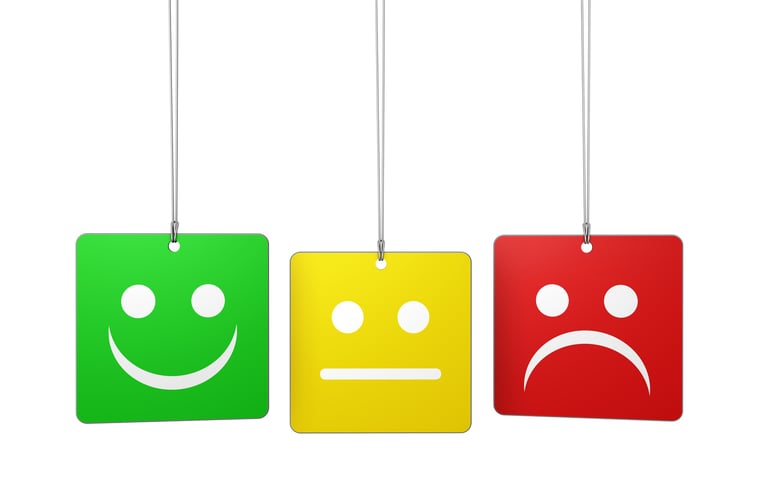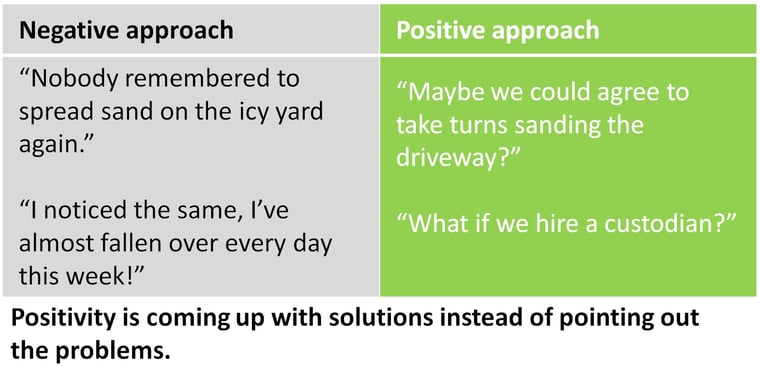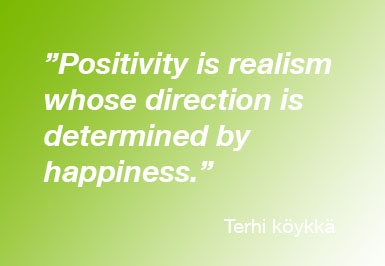

[In English below] Positiivisuudesta on vaikea kirjoittaa kuulostamatta onnelliselta hörhöltä. Positiivisuus on saanut turhankin epärealistisen maineen ja paradoksaalisesti sana saattaa aiheuttaa negatiivisia tunteita. Tästä huolimatta yritän kirjoittaa oman näkemykseni siitä, kuinka positiivisuus vaikuttaa työilmapiiriin.
Tunne tarttuu
Kuvitellaan tilanne, jossa yhdellä henkilöllä työyhteisössä on paha olla. Hän valittaa, tuo esiin jatkuvasti kaikenlaisia pikkuongelmia eikä mikään ole koskaan hyvin. Hän keskustelee työkaverin kanssa, jonka on helppo lähteä mukaan narinaan. Kohta vieruskaverikin alkaa kiinnittää huomiota negatiivisiin asioihin ja levittää pahaa oloa. Kierre on saatava pysäytettyä ennen kuin paha olo on levinnyt kaikkiin työyhteisön jäseniin ja työilmapiiri on muuttunut raskaaksi. Negatiiviselle työkaverille on kerrottava yksityisesti ja selkeästi, että tällaisen käytöksen on loputtava. Hänelle täytyy tarjota mahdollisuus valittaa asioista suoraan esimiehelle, ja tällaisessa keskustelussa on hyvä selvittää, mikä ongelmien perimmäinen syy on. Tämä vaatii rohkeutta kysyä suoraan.
Ennen kuin edellä kuvattua tilannetta pääsee syntymään, kannattaa herättää tiimi positiiviseen ajatteluun. Positiivinen ajattelu ei ole valittamista ironisesti positiivisin sanankääntein.

Positiivinen keskustelun pohjavire poikii lisää ideoita ja ratkaisuja, kun taas negatiivinen tapa levittää pahaa mieltä. Moni ajatteleva ihminen jo sisimmässään tietää, kuinka asia pitäisi hoitaa. Tiimin jäseniä pitäisi kannustaa tuomaan näitä ideoita esiin. Aina tämä tietenkään ei ole mahdollista, jolloin ongelmien esiin tuomisen salliminen on kuitenkin tärkeää. Edward de Bonon Lateraalisen ajattelun kurssilla opin, että ”huononkin” idean takana voi olla toimiva konsepti. Konseptiajattelua voidaan opettaa seuraavalla, joskin vähän negatiivisella esimerkillä:

Konseptiajattelussa mietitään, mihin idea alun perin perustui. Tässä idean konsepti on ”Tapa rangaista roskaamisesta”. Tätä konseptia vasten ideointi onkin jo helpompaa.
Myönteinen ilmapiiri kannattaa
Meidän yrityksessämme on upea tapa. Kun joku avokonttorissa onnistuu, tiimi alkaa taputtaa. Taputukset leviävät koko konttoriin, ja hetken kaikilla on iloinen mieli. Tapaa ei ole mitenkään tietoisesti lanseerattu, vaan se on lähtenyt itsestään liikkeelle. Taputuksia ei kuulu joka päivä. Ei edes viikoittain. Silloin kun ne kuuluvat, kaikki tietävät että joku on todella onnistunut ylittämään odotukset. Onnistumisesta saa ja pitää olla ylpeä.
Mutta elämä ei ole kuitenkaan yhtä ruusuilla tanssimista. Virheitä sattuu. Myönteisessä ilmapiirissä virheet saa tunnustaa. Mikäli virheisiin suhtaudutaan yrityksen ja esimiesten taholta ymmärtävästi, vahinko ei ehdi levitä kauas. Mitä pidemmälle virhe pääsee, sitä kalliimmaksi se yritykselle tulee. Virheen piilottelu saattaa aiheuttaa kustannusten kasvamisen radikaalisti.
 Esimerkiksi jogurttitehtaalla pudotat vahingossa purkan purkkiin. Kerrot rehellisesti virheestä, ja yksi erä menee pilalle. Kustannukset voivat olla suuretkin. Suuremmat ne ovat kuitenkin silloin, kun eräänä aamuna luet lehdestä purkan löytyneen. Koko tehtaan hygienia kyseenalaistetaan ja maineeseen tulee tahra. Jos virheen teko ei ole sallittua, saattaa virheen tekijä piilotella tekemisiään kunnes syyllistä aletaan etsiä. Syyllisen etsimisen sijaan pitää lähteä etsimään ratkaisuja: miten pääsemme eteenpäin mahdollisimman sujuvasti, vaikka virhe on tapahtunut?
Esimerkiksi jogurttitehtaalla pudotat vahingossa purkan purkkiin. Kerrot rehellisesti virheestä, ja yksi erä menee pilalle. Kustannukset voivat olla suuretkin. Suuremmat ne ovat kuitenkin silloin, kun eräänä aamuna luet lehdestä purkan löytyneen. Koko tehtaan hygienia kyseenalaistetaan ja maineeseen tulee tahra. Jos virheen teko ei ole sallittua, saattaa virheen tekijä piilotella tekemisiään kunnes syyllistä aletaan etsiä. Syyllisen etsimisen sijaan pitää lähteä etsimään ratkaisuja: miten pääsemme eteenpäin mahdollisimman sujuvasti, vaikka virhe on tapahtunut?
Esimiehen tehtävä on johtaa esimerkillään. Itse yritän virheitä tehdessäni pysähtyä, katsoa peiliin, pyytää anteeksi ja luvata, etten tee samaa virhettä toistamiseen. Uudelleen tilanteeseen joutuessani muistan lupaukseni ja pyrin toimimaan toisella tavalla.
Älä hyväksy negatiivisuutta edes vitsillä
Vanhan sanonnan mukaan vitsissä on puoli totuutta. Kun huomaan jonkun vitsailevan negatiiviseen sävyyn, alkavat hälytyskellot soida: joku on hätänä. Yksittäinen negatiivinen vitsailu kannattaa katkaista ja kysyä mikä hätänä. Taustalla saattaa olla oikea ongelma. Jos yleinen tunnelma hyväksyy negatiivisen vitsailun tai toisen pilkkaamisen, jollekin tulee lopuksi paha olla. Sellainen repii tiimiä yksilöihin. Työtä tehdään tiimeissä syystä. Jos tiimillä on voimakas ryhmähenki, saadaan tiimityön edut käyttöön. Porukassa viisauskin tuntuu tiivistyvän. Negatiivisessa ympäristössä tiimi on vain joukko yksilöitä, jotka osoittavat muiden virheitä ja korostavat omia onnistumisiaan.
Positiivisuutta voi oppia
 Positiivisuus alkaa itsestä. Sen sijaan että mollaat itseäsi virheistä, anna ne itsellesi anteeksi. Kaikki tekevät virheitä, mutta se, miten siitä jatketaan eteenpäin, kertoo ammattitaidosta enemmän kuin itse virhe. Tilanteeseen on helppo jäädä vellomaan, piilotella virhettä tai jopa syyttää jotakuta muuta. Todellista ammattitaitoa on myöntää virheensä ja aloittaa jälkien korjaaminen mahdollisimman nopeasti.
Positiivisuus alkaa itsestä. Sen sijaan että mollaat itseäsi virheistä, anna ne itsellesi anteeksi. Kaikki tekevät virheitä, mutta se, miten siitä jatketaan eteenpäin, kertoo ammattitaidosta enemmän kuin itse virhe. Tilanteeseen on helppo jäädä vellomaan, piilotella virhettä tai jopa syyttää jotakuta muuta. Todellista ammattitaitoa on myöntää virheensä ja aloittaa jälkien korjaaminen mahdollisimman nopeasti.
Seuraava askel positiivisuuden oppimiseen on kannustaminen. Kiinnitä huomiota onnistumisiin. Ole ylpeä itsestäsi, kun onnistut. Ole ylpeä työkaveristasi, kun hän onnistuu. Kerro, että huomasit onnistumisen. Anna hyvän kiertää.
Related articles:
______________________________________________________________________________________________
Positivity isn't unicorns and cotton candy
It is difficult to write about positivity without sounding like a happy hippie. Positivity has gained an unnecessarily unrealistic reputation and, paradoxically, the word can cause negative emotions. Despite this, I will try to give my take on how positivity impacts the atmosphere at work.
Moods are contagious
Let’s imagine a situation in which one person in a work community feels bad. He complains, keeps bringing up the tiniest problems and nothing is ever good enough. He chats with a fellow employee who finds it easy to join in on the complaining. Soon the person sitting next to him begins to notice negative things and spreads the bad vibes. The downward spiral needs to be stopped before the negative mood spreads to the other members of the work community and the mood turns sour. The negative colleague needs to be told privately and firmly that this type of behavior has got to stop. He must be offered the possibility to complain about things directly to his supervisor and discussions like this need to get to the bottom of what is behind it all. This requires the courage to ask direct questions.
Before the situation described above can develop, it’s worthwhile awakening your team to positive thinking. Positive thinking is not complaining using ironically positive phrasing.

The undercurrent of positive discussions spawns additional ideas and solutions, while negative approaches cause bad feelings to spread. Many thinking people already know, in their gut, how things should be taken care of. A team’s members should be encouraged to bring their ideas out into the open. This is not always possible, of course, in which case it is important for people to be allowed to bring up problems. At Edward de Bono’s lateral thinking course I learned that a “bad” idea could actually be based on a viable concept. Conceptual thinking can be taught using the following, albeit negative, example:

Conceptual thinking delves into what the idea is originally based on. In this case the concept is “How to punish for littering”. Coming up with ideas is easier against this concept.
A positive atmosphere is worthwhile
Our company has a great tradition. When someone in our open plan office succeeds, the entire team starts clapping. The clapping spreads to the entire office and everyone feels happy for a moment. The tradition hasn’t been launched consciously in any way – it just took off by itself. We don’t hear clapping every day. Or even every week. When we hear clapping, we know that someone has entirely exceeded expectations. People are allowed to be, and should be, proud of their successes.
But life isn’t just a bowl of cherries. Mistakes happen. In a positive atmosphere you can admit to your mistakes. If the company and supervisors take an understanding view of mistakes, the damage won’t spread very far. The further along the mistake spreads, the costlier it is for the company. Hiding mistakes may cause costs to rise dramatically.
 Imagine dropping your gum into a vat of yoghurt at a yoghurt factory. You admit your mistake freely and one batch is ruined. The costs may even be high. The costs would be higher, however, when one morning you happen to read in the paper that someone has found the gum. The hygiene of the entire factory would be called into question and its reputation smeared. If it isn’t permitted to make mistakes, the person making the mistake may hide their actions until the search for the culprit starts. Instead of looking for the guilty party, the search should focus on solutions: how can we move forward as smoothly as possible despite the mistake?
Imagine dropping your gum into a vat of yoghurt at a yoghurt factory. You admit your mistake freely and one batch is ruined. The costs may even be high. The costs would be higher, however, when one morning you happen to read in the paper that someone has found the gum. The hygiene of the entire factory would be called into question and its reputation smeared. If it isn’t permitted to make mistakes, the person making the mistake may hide their actions until the search for the culprit starts. Instead of looking for the guilty party, the search should focus on solutions: how can we move forward as smoothly as possible despite the mistake?
A supervisor’s job is to be an example. When I make mistakes, I try to look in the mirror, apologize and promise not to make the same mistake again. When I end up in the same situation later, I remember my promise and try to act differently.
Don’t accept negativity – not even as a joke
An old saying goes: Many a true word is spoken in jest. When you notice someone making jokes with a negative tone, alarm bells start going off: something is the matter. It pays to cut off individual negative jokes and ask if something is wrong. A real problem may lay behind the comedy. If the general atmosphere at work accepts negative jokes or mocking others, someone is bound to have their feelings hurt in the end. It rips the team apart into individuals. Work is performed in teams for a reason. If a team has a strong spirit of togetherness, the benefits of teamwork are achieved. Many heads are better than one. In a negative environment, the team is just a bunch of individuals pointing out each other’s mistakes and highlighting their personal successes.
Positivity can be learnt
 Positivity begins with you. Instead of beating yourself over the head with your mistakes, forgive yourself. Everyone makes mistakes, but what you do afterwards tells us a lot more about your competence than the mistake itself. It’s easy to wallow in the situation, hide the mistake or even try to blame someone else. A true professional admits their mistakes and starts the clean-up process as quickly as possible.
Positivity begins with you. Instead of beating yourself over the head with your mistakes, forgive yourself. Everyone makes mistakes, but what you do afterwards tells us a lot more about your competence than the mistake itself. It’s easy to wallow in the situation, hide the mistake or even try to blame someone else. A true professional admits their mistakes and starts the clean-up process as quickly as possible.
The next step in learning positivity is encouragement. Pay attention to successes. Be proud of yourself when you succeed. Be proud of your colleagues when they succeed. Mention that you noticed the success. Pay it back.
Related articles:

